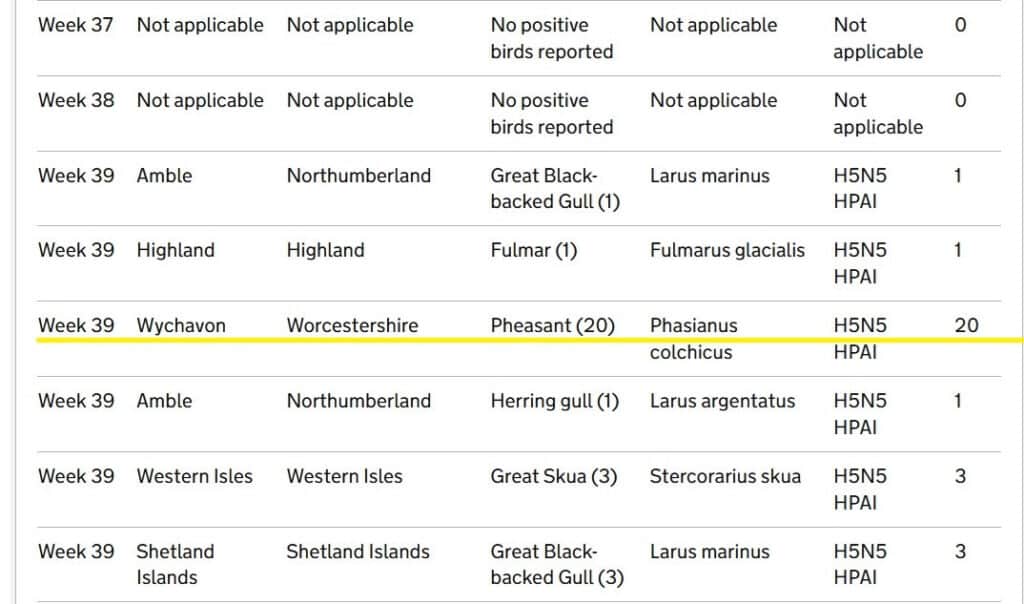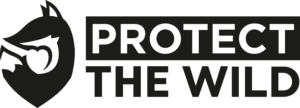The Animal and Plant Health Agency (APHA) has reported an outbreak of Highly Pathogenic Avian Influenza (HPAI H5N5) in 20 pheasants released onto a Worcestershire shoot.
The outbreak was recorded on APHA’s weekly updated database for week 39 – in other words between 23-29 September – in Wychavon. No precise location details are provided and the shoot is not named, but there are at least nineteen shoots listed for Worcestershire on GunsOnPegs alone and between them they will have released tens of thousands of birds for shooting.
The shooting industry has recent form when it comes to Avian Flu, as Protect the Wild has noted previously. In May 2023 Avian Flu protection zones were imposed around Bettws Hall Game Farm in Powys, which describes itself as ‘a market leader in the production of pheasant and partridge chicks and poults in the UK‘, raising more than 1.7m pheasant and partridge chicks a year which it sells to shooting estates. In September 2023 the Animal and Plant Health Agency reported that four pheasants were confirmed with Avian Flu somewhere in Moray, Scotland in Week 35 (August 28 to September 3, 2023).
Looking at the recent previously encouraging list of confirmed cases of Avian Flu in the UK (see APHA table below) – a disease that has spread right around the world since it was first found in unhygienic and intensive poultry production units in East Asia – shows just how serious the outbreak is. According to APHA figures, there had been just 17 confirmed cases in the whole of 2024 up until Week 38 (confirmed doesn’t of course include cases where birds have died and not been tested or even found).

Avian Flu though, like Covid, hasn’t just gone away and it is still evolving. Millions of wild birds have now been killed. Globally it is causing outbreaks in poultry and U.S. dairy cows with several recent human cases in U.S. dairy and poultry workers; in Canada, H5N5 was found in the bodies of four dead Raccoons and a Skunk; the virus caused ‘extreme mortality’ in Elephant Seal pups in Argentina in late 2023; in December 2023, the H5N1 strain of the virus was found to have infected a Polar Bear for the first time.
In the UK at least 78 UK bird species have now tested positive for Avian Flu. Seabirds have suffered huge losses and “HPAI has become one of the biggest immediate conservation threats” faced by many seabird species. In summer 2022 they were hit extremely hard. Thousands of Gannets died at RSPB Troup Head and at RSPB Grassholm. 2,500 Great Skuas in Scotland died. A quarter of the Roseate Terns on Coquet Island, the only breeding colony of this scarce and declining species in the UK, died. None have recovered their populations yet.

Avian Flu and the Shooting Industry
Like other viruses, Avian Flu mostly spreads from bird to bird through direct or indirect contact with infected saliva, nasal secretions or droppings (which makes the intensive conditions under which chicks are reared for the shooting industry perfect for transmission) as well as through predation and scavenging – so through corvids and foxes scavenging the infected bodies of dead and dumped pheasants, perhaps?
The industry ensures the birds it rears are trucked out far and wide to the literally hundreds of shoots now blighting the countryside. Some 40 million Common Pheasants and 10 million Red-legged Partridges are released to be shot every year, and because shooting has had many supporters in Parliament the legislation that impacts how those birds are considered, leads, in the words of Raptor Persecution UK’s Dr Ruth Tingay, to their ‘idiotic legal status’. Once the birds are released they are no longer considered livestock (as they were when being reared) but ‘wild birds’ – which means that no restriction zones can be put in place to stop them spreading the virus to wildlife.
Can they spread the virus to wildlife? Once shots start to be fired, the chances of the virus being spread by infected birds rapidly escalate. The virus is expelled in faeces, and birds routinely defecate to make themselves lighter when threatened: what might that mean for the innumerable wild birds that are using the same woodlands and fields as pheasants? And anyone who’s ever been birding when shots start to ring out will have witnessed just how fast and how far startled flocks of birds in the locality will actually fly.
Warnings ignored
Warnings that releasing so many birds into the wider countryside simply to be shot at could spread Avian Flu were sounded by the RSPB back in August 2022. They asked then for a moratorium on releases which was totally ignored (and in some cases mocked by shooting lobbyists). Inevitably, by the 22nd of September 2022 ITV News was reporting that ‘…for the first time this year pheasants in Cornwall, Cheshire and Norfolk have tested positive for the H5N1 virus’.
Protect the Wild has asked on previous occasions whether a government that allows the shooting industry to ignore valid concerns is serious about protecting wildlife from Avian Flu at all. We don’t yet know whether the operators of the unnamed shoot where these birds were found have closed the shoot for the ‘season’, but there is only a narrow window (between September and the end of January) for lowland shoots flogging partridges and pheasants to shooters to recoup costs and make money. And this is not an industry renowned for its ethics or considerations of the wider impacts of its activities.
Back in November 2022 we wrote this about shooting’s determination to continue its operations despite the risk to wildlife:
“It is absolutely abhorrent to many of us that while wild birds are living under such a threat and the risks of spread is not (despite APHA’s reassurances) fully understood, the shooting industry should ignore the pleas of experts from eg the RSPB, and carry on anyway.
Abhorrent, but sadly typical of a selfish industry incapable of compassion and – it appears – constraint.”
Almost two years later nothing has changed – and neither has our opinion of one of the UK’s most pointless and self-regarding industries.

